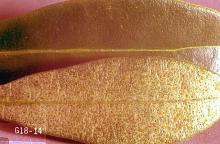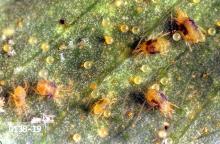Includes
Brown mite (Bryobia rubrioculus)
European red spider mite (Panonychus ulmi)
McDaniel spider mite (Tetranychus mcdanieli)
Twospotted spider mite (Tetranychus urticae)
Yellow spider mite (Eotetranychus carpini borealis)
Pest description and crop damage Several species of mites can cause damage in tree fruits. The principal mite pests of plums and prunes include the European red spider mite and the twospotted spider mite. Other mite species include the yellow spider mite, brown mite, and McDaniel spider mite. The appearance of these mites varies with the species, although all are very small, 0.5 mm or smaller. Their color may be light yellow-greenish, red, or brownish. Mites damage fruit indirectly by feeding on leaves, which causes stippling, bronzing, and possibly leaf drop. The reduction in photosynthesis causes loss of vigor and yield.
Biology and life history Depending on species, mites overwinter as eggs or adult females under bark, on smaller branches or fruit spurs, or in ground cover. Mites become active in the spring. There may be numerous overlapping generations per year.
Pest monitoring Observe the leaves for these mites and webbing but also check for the presence of predator mites. Typically, sufficient control is achieved by midsummer by biological agents.
Management-biological control
Predatory phytoseiid mites tend to keep pest mites under control if broad-spectrum insecticide applications are avoided. Phytoseiid mites are similar in size to spider mites, but are shiny, more translucent, and move faster than spider mites. Heavy rain and cold weather also suppress mite numbers.
Management-cultural control
Broadleaf weeds like mallow, bindweed, white clover, and knotweed enhance mite numbers. Suppression of these weeds with cultivation or grasses may reduce mite numbers. Mites can be washed from the tree with a strong stream of water. Water trees properly, as drought-stressed trees are more susceptible. Avoid excessive nitrogen applications, as this encourages mites.
Management-chemical control: HOME USE
Dormant-season spray
Apply only during dormant or delayed-dormant period. Use enough water to cover all the tree thoroughly including small limbs and shoots.
- horticultural mineral oil (for European red mite only)-Some formulations are OMRI-listed for organic use.
- sulfur products-Some formulations are OMRI-listed for organic use.
Growing-season spray
Some growing-season sprays can cause additional pest outbreaks and kill natural enemies. Dormant-season sprays can be effective in reducing future mite populations.
- azadirachtin (neem oil)-Some formulations are OMRI-listed for organic use.
- gamma-cyhalothrin-Highly toxic to bees.
- horticultural mineral oil-Some formulations OMRI-listed for organic use.
- insecticidal soap-Some formulations are OMRI-listed for organic use.
- lambda-cyhalothrin-Highly toxic to bees.
- plant-derived essential oils-Some have shown efficacy against spider mites. Some formulations are OMRI-listed for organic use.
- pyrethrins-Highly toxic to bees. Some formulations are OMRI-listed for organic use.
- spinosad-Toxic to bees. Some formulations are OMRI-listed for organic use.
Management-chemical control: COMMERCIAL USE
Dormant-season spray
Apply only during dormant or delayed-dormant period. Use enough water to cover all the tree thoroughly including small limbs and shoots.
- horticultural mineral oil (rates vary; check product label) (on European red mite only)-Use oil at the highest concentration only in the dormant period. REI varies; check product label. Some formulations are OMRI-listed for organic use.
Growing-season spray
- abamectin (Abamex) at 10 to 20 fl oz/A. May be applied with a horticultural mineral oil at 1 quart/100 gal (1 gal/A). REI 12 hr. PHI 21 days. Apply when mites first appear. Do not exceed two applications per season.
- bifenazate (Acramite 50WS) at 0.75 to 1 lb/A. REI 12 hr. PHI 3 days. Limited to one application per season.
- fenbutatin-oxide (Vendex 50WP) at 1 to 2 lb/A. REI 48 hr. PHI 14 days. Apply when mites first appear. Do not exceed two applications per season.
- hexythiazox (Savey 50DF) at 3 to 6 oz/A. REI 12 hr. PHI 28 days. Most effective when directed to egg stage; not effective on adults. Do not exceed one application per season.
- spirodiclofen (Envidor 2SC) at 16 to 18 fl oz/A. REI 12 hr. PHI 7 days. Limited to one application per season.
Resistance management Always rotate products as spider mites can develop resistance rapidly to any one chemical.





